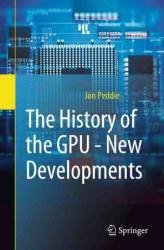 Название: The History of the GPU - New Developments
Название: The History of the GPU - New DevelopmentsАвтор: Jon Peddie
Издательство: Springer
Год: 2022
Страниц: 434
Язык: английский
Формат: pdf (true)
Размер: 18.7 MB
This third book in the three-part series on the History of the GPU covers the second to sixth eras of the GPU, which can be found in anything that has a display or screen. The GPU is now part of supercomputers, PCs, Smartphones and tablets, wearables, game consoles and handhelds, TVs, and every type of vehicle including boats and planes.
In the early 2000s the number of GPU suppliers consolidated to three whereas now, the number has expanded to almost 20. In 2022 the GPU market was worth over $250 billion with over 2.2 billion GPUs being sold just in PCs, and more than 10 billion in smartphones.
Understanding the power and history of these devices is not only a fascinating tale, but one that will aid your understanding of some of the developments in consumer electronics, computers, new automobiles, and your fitness watch.
A mesh shader was a new type of shader that combined vertex and primitive processing. It replaced the vertex shaders (VS), hull shaders (HS), Domain shaders (DS), and geometry shader (GS) stages with an amplification shader and mesh shader. Roughly, mesh shaders replace VS + GS or DS + GS shaders, and amplification shaders replace VS + HS. The amplification shader allowed programmers to decide how many mesh shader groups to run, and it passed data to those groups. The amplification shader eventually replaced hardware tessellation. As a result, the GPU became a compute engine. DirectX 12 Ultimate also included DXR 1.1, which enabled RayQuery from any shader stage.
The Turing GPU architecture included features to improve the performance of data center applications, such as an improved video engine and a multi-process service. Nvidia claimed Turing improved inference performance for small batch sizes, reduced launch latency, and enhanced quality-of-service (QoS) while supporting a more significant number of concurrent client requests. The Turing-based Tesla AIBs offered a higher memory bandwidth and larger memory size than the prior generation Pascal-based Tesla AIBs and targeted similar server segments. It also provided a greater user density for virtual desktop infrastructure (VDI) applications. With Turing, Nvidia introduced three significant new developments that rocked the industry:
- real-time ray tracing (RTRT)
- Deep-learning anti-aliasing
- Deep learning supersampling
- Hybrid-rendering
- variable rate shading
- mesh shaders
Contents:
1. Introduction
2. The Third- to Fifth-Era GPUs
3. Mobile GPUs
4. Game Console GPUs
5. Compute Accelerators and Other GPUs
6. Open GPU Projects (2000–2018)
7. The Sixth Era GPUs: Ray Tracing and Mesh Shaders
8. Concluding Remarks
Скачать The History of the GPU - New Developments